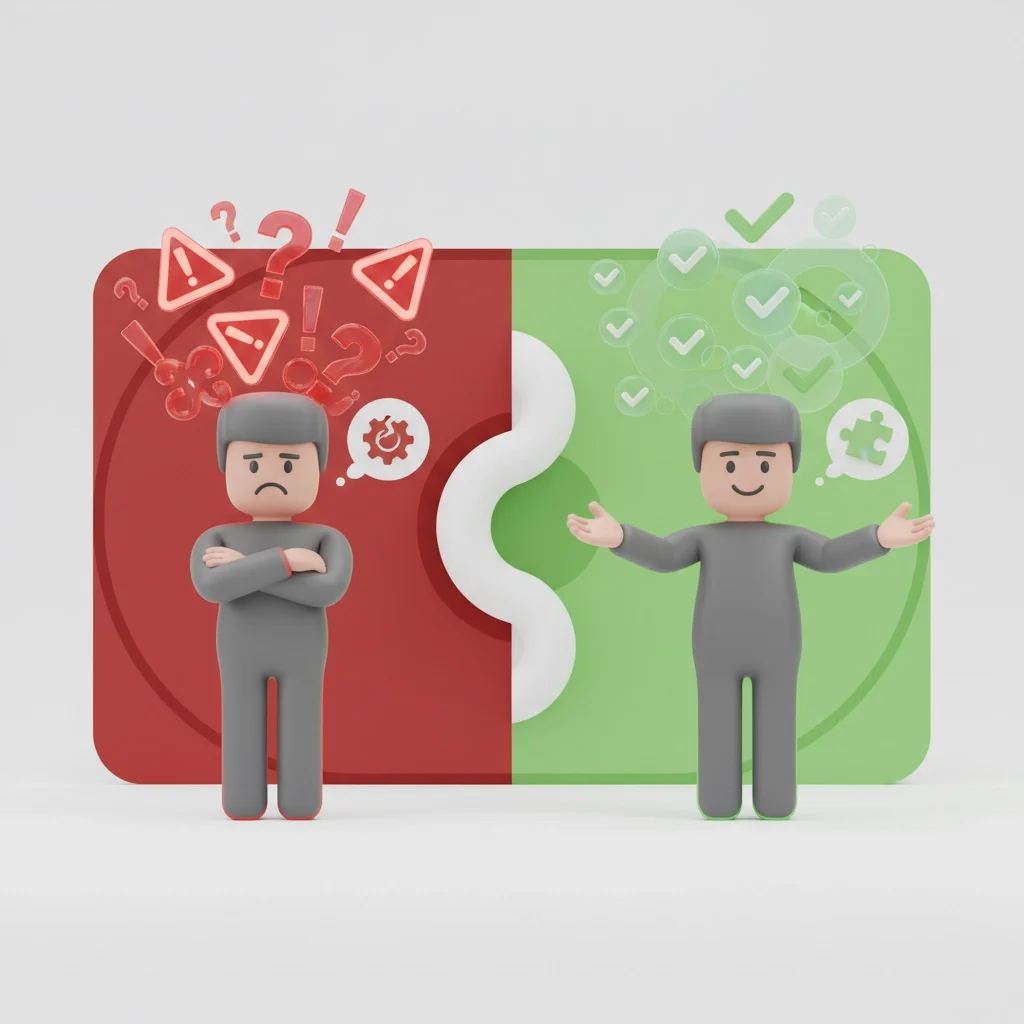Building Trust With Clear Customer Choices
Picture this: You've just spent hours crafting the perfect optional service offering for your customers. You're excited about giving them choices and protecting their interests. Then boom, a customer accuses you of being "not transparent" and says you've "ruined their fun."
Sound familiar? You're definitely not alone. This scenario plays out daily across every industry, from boat rentals to software subscriptions. The good news? It's totally fixable with the right approach.
Why Customers Feel Pressured (Even When They Shouldn't)
Let's be real, customers today are on high alert for hidden fees and surprise charges. They've been burned before by companies that buried important details in fine print or sprung unexpected costs at checkout. When you present an optional service, even with the best intentions, some customers automatically assume there's a catch.
This defensive mindset isn't personal. It's learned behavior from dealing with less-than-honest businesses. Your job is to break through that wall of skepticism with crystal-clear communication.
The Timing Problem Most Businesses Miss
One of the biggest trust-killers happens when customers feel like information is being "sprung on them" at the wrong moment. Think about it, if someone's already mentally committed to a purchase, suddenly introducing new options can feel manipulative, even when it's genuinely helpful.
The solution? Front-load your transparency. Put optional services right where customers can see them during the initial booking or inquiry process. Don't save them for a follow-up call or separate email unless absolutely necessary.
For example, if you're running a rental business, mention insurance options right on your booking page alongside your base rates. SaaS companies can list add-on features during signup rather than waiting for onboarding calls. This approach lets customers make informed decisions from the start.
The Language That Builds Trust vs. Creates Doubt
Words matter, probably more than you think. The difference between "You'll need to consider insurance" and "You have the option to add insurance if you'd like extra peace of mind" is huge. The first sounds like a requirement hiding behind polite language. The second clearly positions it as a choice.
Here are some trust-building phrases that work across industries:
"Completely optional" instead of "recommended"
"Available if you're interested" rather than "offered"
"Many customers choose to add" vs. "You should consider"
"Feel free to decline" instead of not mentioning they can say no
Small word changes can eliminate that feeling of pressure customers often experience. It's about making your genuine intent clear through your language choices.
Industry-Specific Transparency Strategies
Service-Based Businesses (Contractors, Consultants, Agencies)
When you're dealing with project-based work, customers want to know about potential add-ons upfront. Create a clear breakdown of your base service and list common optional extras with transparent pricing.
For instance, if you're a contractor, separate your core demolition work from optional debris removal. Show both prices clearly so customers can budget accordingly. This prevents those awkward conversations later about "unexpected" costs.
Rental Businesses (Equipment, Vehicles, Vacation Properties)
The key here is normalizing optional protections without making them feel mandatory. Use industry comparisons customers already understand: "Like rental car insurance, this coverage is available if you want extra protection."
Display your liability policies clearly alongside optional coverage. When customers understand what you already cover versus what they're responsible for, optional insurance feels less like a money grab and more like genuine protection.
Software and Digital Services
SaaS transparency works best with clear feature tiers and upgrade paths. Instead of hiding advanced features behind paywalls, show customers exactly what they get at each level. Use comparison charts and feature matrices to make choices obvious.
Many successful software companies send welcome emails that explain upgrade options without pushing them. Something like: "You're all set with our Pro plan! If you ever need advanced reporting, our Enterprise tier is available: but you're good to go as-is."
Building Trust Through Documentation
Documentation isn't just about covering yourself legally: it's about building confidence. When customers can easily find information about policies, options, and pricing, they feel more in control of their decisions.
Create simple, scannable documents that explain:
What's included in your base service
What optional add-ons are available and why
Clear pricing for everything
Your refund or cancellation policies
How customers can decline optional services
The goal is giving customers enough information to make confident choices without overwhelming them with legal jargon. Think FAQ format rather than terms-and-conditions wall of text.
This approach aligns perfectly with building accountability without micromanagement: you're empowering customers to make their own informed decisions rather than trying to control their choices.
The Follow-Up Call That Actually Builds Trust
If you do follow-up calls (and you should: they're great for customer service), frame them around confirmation and support, not selling. Lead with something like: "I'm calling to confirm your booking details and answer any questions about your upcoming rental."
Then address optional services naturally: "You'll see an optional insurance page before your trip. It's there if you want it, but totally fine to skip if you'd prefer not to add it. Either way, you're all set."
This positions you as helpful rather than pushy. You're giving information, not applying pressure. The customer feels supported in whatever choice they make.
When Customers Still Feel Pressured
Sometimes, despite your best efforts, customers will still feel uncomfortable about optional services. This often stems from past bad experiences or general anxiety about hidden costs. Here's how to handle it:
First, acknowledge their concern: "I understand your hesitation. A lot of businesses do hide fees, and it's frustrating." Then clarify your position: "That's exactly why we put all our options upfront and make everything truly optional."
If they're still uncomfortable, offer to remove the option entirely from their experience: "Would it help if I flag your account so you don't see the insurance page at all? You can always add it later if you change your mind."
This level of flexibility shows you're genuinely focused on their comfort, not making extra money. It builds trust even with initially skeptical customers.
Making Optional Services Feel Like Benefits
The most successful businesses position optional services as customer benefits rather than revenue opportunities. They focus on solving customer pain points, not padding profit margins.
For example, instead of: "We offer optional insurance to protect against damage costs," try: "Many customers appreciate having insurance available so they can relax and enjoy their experience without worrying about unexpected expenses."
The difference is subtle but powerful. You're positioning the service as something that enhances their experience rather than something that protects your business.
The Role of Consistency in Building Trust
Trust builds over time through consistent experiences. If your website says one thing, your email says another, and your phone call introduces new information, customers rightfully feel confused and suspicious.
Audit all your customer touchpoints to ensure they tell the same story about optional services. Your website, confirmation emails, follow-up calls, and documentation should all present the same information in the same way.
This consistency principle applies to team management too. Just like aligning remote teams requires consistent communication, aligning customer expectations requires consistent messaging across all touchpoints.
Learning From Customer Feedback
Pay attention to how customers react to your optional service presentations. If multiple people feel pressured or surprised, there's room for improvement in your approach: not necessarily your offerings.
Track common questions or concerns customers raise. These insights help you refine your communication strategy. Maybe customers consistently ask about cancellation policies, suggesting you should address that upfront. Or perhaps they're confused about what's included versus optional, indicating your base service description needs work.
This feedback loop helps you build time, trust, and transparency in your work culture, creating better experiences for everyone involved.
The Long-Term Trust Payoff
Businesses that master transparent optional service communication see real benefits beyond avoiding negative feedback. Customers who feel empowered to make informed choices tend to:
Become repeat customers more often
Refer friends and family with confidence
Leave positive reviews highlighting your honesty
Actually purchase optional services more frequently (because they don't feel pressured)
It's counterintuitive but true: the less you push optional services, the more likely customers are to choose them. When people feel in control of their decisions, they're more comfortable making additional purchases.
The trust you build through clear choices extends far beyond individual transactions. It becomes part of your brand reputation and competitive advantage in markets where customers have plenty of options.
Building trust through clear customer choices isn't about perfect scripts or foolproof systems. It's about genuinely respecting your customers' autonomy and intelligence. When you consistently demonstrate that respect through transparent communication and flexible options, trust naturally follows.
Remember, every customer interaction is an opportunity to either build or erode trust. Choose transparency every time, even when it feels like extra work upfront. Your customers: and your business: will thank you for it.




